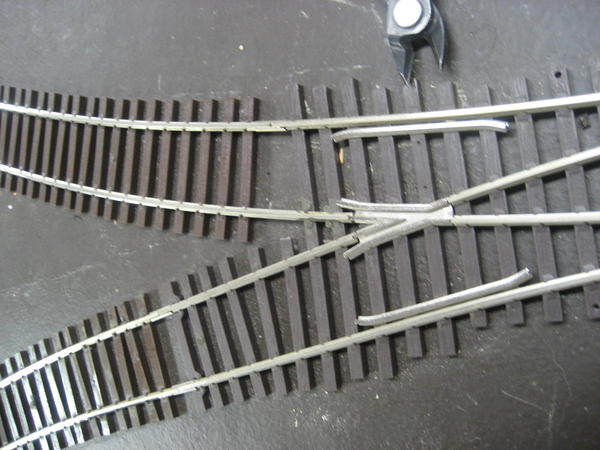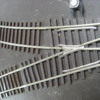I'm tossing around the idea of a small 2-rail switching/display deck and was thinking about using some cut-down Atlas #5 turnouts. How are the mechanical properties of the turnouts? The plan is to use ME flex for everything else.
Replies sorted oldest to newest
I slapped mine down 4 years? ago, with power drops on each leg and there still great! I still need to add some type of machine for routing. I bought their table top machines and never mounted them. I might just use the Caboose Hobbies manual ground throws where I can reach them.
I was thinking of using a couple of Tortoise motors and their relay contacts. By the way, Litchfield sells the AccuLites edge cards for easier wiring (I love those things.)
Chris
Matt,. just found another photo that may help. At a Atlas wye location I needed the branch line to stay on a curved radius so I removed the tangent diverging track closer to the frog than normal. This only left a sliver of rail adjacent to the frog which fell out like a baby's tooth.
I just rolled a continuous flex track section and then cut the stub back staggered into the constant curve and slipped the long end into the remaining tie plate next to the frog.
This demonstrates how radical you can cut away at Atlas diverging ends. Not that easy at the point end IME.
Attachments
Matt,. just found another photo that may help. At a Atlas wye location I needed the branch line to stay on a curved radius so I removed the tangent diverging track closer to the frog than normal. This only left a sliver of rail adjacent to the frog which fell out like a baby's tooth.
I just rolled a continuous flex track section and then cut the stub back staggered into the constant curve and slipped the long end into the remaining tie plate next to the frog.
This demonstrates how radical you can cut away at Atlas diverging ends. Not that easy at the point end IME.
That's good to know as I was also looking at that particular turnout as well. The only catch is the point radius is only about 36".
The key it is a 36" radius for a very short span which may work out for select branch line equipment.
Brad Strong can make a wye in any configuration.
I think you will find that the Atlas wye has a #2-1/2 frog which is the same as a left #5 and right #5 turnout superimposed (with the straight parts missing).
The radius of the closure rails (the smallest radius of the turnout) is somewhere between 50 and 54" depending on how accurately the turnout was designed.
The radius of the switch (this is the part of the turnout that includes the points and some of the closure rails) should be in the range of 80-85 inches.
I have one on my layout leading to the turntable. I regularly run full length passenger cars, E8 and PA1 diesels through it just the same as a few other #5 turnouts on the layout.
A check of the NMRA RP12 will confirm this.
Jim, I do not know what the actual radius midway through the wye is but after extensive testing for selecting turnouts for a layout build project using larger engines we have determined that ?-10-? engines which will make it through an Atlas #5 will climb the rails in the "#5" wye. (I am running low on periods so I had to run it all together)
Lay one over the other and you will see that the rail curvature between the points and the frog does not run the same. The wye curve runs tighter/deeper.
Of course the Atlas #5 is kinda weird in that the diverging point is actually cast on a curve 3 rail style.
Matt,
Another option is
http://www.signatureswitchco.c...number_turnouts.html
I contacted him recently about making some #5 turnouts for industrial switching and here was his response:
'I hadn't given much thought to a #5 as a stock item but, I'd be happy to build some for you. The price for a #5 right or left would be $70.00 each. Just let me know what you need and I'll build it for you.
Thank you for your interest,
Brad Strong"
Bill McBrde
Matt,
Another option is
http://www.signatureswitchco.c...number_turnouts.html
I contacted him recently about making some #5 turnouts for industrial switching and here was his response:
'I hadn't given much thought to a #5 as a stock item but, I'd be happy to build some for you. The price for a #5 right or left would be $70.00 each. Just let me know what you need and I'll build it for you.
Thank you for your interest,
Brad Strong"
Bill McBrde
Thanks Bill. I'll definitely keep that in mind. I liked what I saw on the site.






